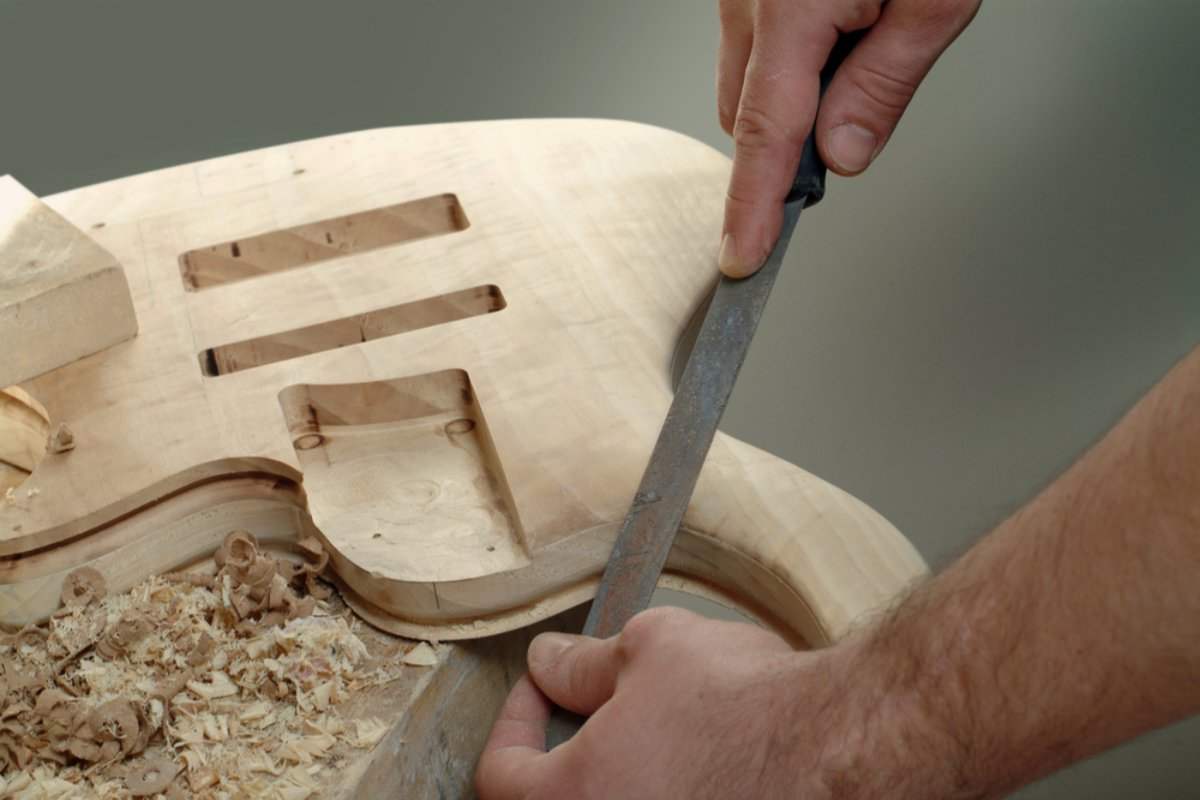Let me invite you on a journey. This is the first of a four-part article that covers everything you need to know about electric guitar pickups. Yes, we created a comprehensive resource to grant you all the answers in a single spot.
Why did we do it? Well, let’s face it, there has never been a moment in guitar-playing history with so many options for guitar pickups. So, since the market became so daunting and vast, we created the ultimate guide to help understand what means what in the pickup world.
In this first piece, we’ll cover the basics. Then, we’ll expand to more complex topics as we move forward.
Are you ready for takeoff? Buckle up because we’re starting right now!
What is an Electric Guitar Pickup?
The technology behind a classic, passive electric guitar pickup is very old. Indeed, it’s still the same technology Leo Fender and Orville Gibson used on their earliest electric models. It is all based on the Faraday Law of magnetism and electrical current.
A pickup is, basically, an electromagnetic device. What does that mean? Well, it means that it is a combination of magnet coils wrapped in an extremely thin copper wire forming a magnetic field.
The qualities of the magnets, the thickness of the wire, and the number of turns will determine the magnetic field, and thus, the gain and tone of the pickup.
Does all this feel like mumbo jumbo still? Read on and find out what it’s all about.
What Do Electric Guitar Pickups Do?
You might know that magnets are very susceptible to metal. Well, these pickups work with metal-string guitars only.
How do they work? When the metal strings move, the magnetic field created by the pickup changes. These changes are transformed into an electric current that travels through the circuit to the output jack. The rest, as they say, is sonic history in the making.
As you can see, the pickups are the ones that create the tone of your electric guitar. Yes, that’s how important they are. Therefore, understanding what comes next might get your current instrument closer to the tone in your head. In other words, you might be one pickup away from your dream guitar.
The Electric Guitar Pickup Anatomy
Not all electric guitar pickups are created the same way. You can literally see them in different sizes, colors, and materials. But, what are the basics every passive electric guitar pickup needs to have?
Two Basic Components
Every passive electric guitar pickup needs a source of magnetism to create the field and coil wire to take that electricity to the rest of the circuit. These two basic components will define much of the pickup’s sound and gain.
Historically, there have been two very distinct approaches:
• The Fender Way – Single-coil pickups as found on Stratocaster and Telecaster guitars have six pole pieces wrapped in coil wire. These pole pieces are the magnets and the rest of the pickup structure is just there to keep everything in place. You can test this by approaching the pole pieces with a metal object and witnessing magnetism in action.
• The Gibson Way – Gibson uses a very different approach than Fender. This is very clear if we talk about P-90 pickups. These are single-coil pickups that have six pole pieces made of steel directly in contact with the magnet that’s below them. The whole structure is wrapped in coil wire and held into place by the rest of the pickup structure.
Translating Shape into Tone
What does this difference mean to you, the player? Well, the difference between these designs can not only be seen but also heard.
The Fender-style single-coil pickups with separate magnets per string tend to enhance the overall string definition. You can hear the separation between each note better, and there’s a clear, bright, treble-oriented quality to these pickups.
If you’ve played a Strat or a Tele before, you’ll know that it can cut through the mix better than a guitar with P-90s or humbuckers. This is because of many differences, including the pickup structure and design.
The Gibson-style single-coil and humbucker pickups offer the player a rounder, fatter, seemingly “bigger” tone. Although the string definition isn’t as precise and clear as the one found in the Fender design, the midrange is more aggressive, and the bottom end is tighter.
If you’ve ever played a guitar with P-90s, you’ll know that even though gain levels aren’t too different from Fender’s single-coil pickups, the bite in the midrange makes them gnarly and rocking. Also, they can drive an amp into overdrive more easily.
Different Magnets
Now that you know what these differences in designs mean from a player and technician perspective, it’s time to go a little further. We’re moving into magnet territory and explaining what each type of magnet does for the guitar in terms of tone and gain.
Alnico
Alnico is not a material but an alloy. Its name comes from the elements that are combined to make Alnico, aluminum (approximately 10%), nickel (approximately 18%), and cobalt (approximately 12%).
The remaining 60% of the material is usually mostly iron (approximately 54%) and a bit of copper (approximately 6%). These percentages are not written on stone and, depending on the Alnico batch, they might vary.
Beyond the differences in each batch, Alnico is ordered with Roman numbers in its different iterations. You can find them from Alnico II to Alnico VIII. Beware that what you’re about to read are just the tonal properties of the magnets that then interact with a million other characteristics the guitar might have.
That said, knowing what type of alloy does what might be a great compass for your tone search.
• Alnico II – You might have seen the “Alnico II” label on the Seymour Duncan set made specially for Slash. Well, the Alnico II alloy offers the player a warm, vintage, soft flavor that matches Slash’s gain approach and sought-after tone. He doesn’t play with tons of distortion or goes for a searing shredding tone. On the contrary, his uncanny understanding of melody works best with these open-sounding pickups that offer rounded highs rather than shrill treble tones.
• Alnico III – This is the weakest type in the Alnico family. It is close to what we all know as a vintage tone. The main difference with Alnico II is that the highs are more accentuated and the lows are less tight and more airy. To give you an example, the Alnico used by Gibson to recreate the quintessential PAF pickup from the ‘50s was Alnico III. This alloy is, perhaps, the closest to a true vintage tone.
• Alnico V – The most common Alnico version is Alnico V. This type is present in all kinds of pickups, from humbuckers to single coils. Its tone qualities are an even midrange with singing, chime-like, defined highs, and a strong bottom end. It is also the second-highest output Alnico version in this list and makes a terrific bridge pickup. Although some might consider it to be modern-sounding, it can be spotted in Fender and Gibson’s ‘50s and ‘60s replicas.
• Alnico VIII – This is the least common and most powerful Alnico version you’ll find in the market. What sets it apart is that you can get to high-gain territory retaining the warm vintage flavor of Alnico. Also, dynamics-wise, this pickup offers a much extended range than ceramic pickups while offering similar output.
Ceramic
Ceramic magnets aren’t really made of ceramics. They are made of a material called ferrite, which is mainly iron oxide pressed into a solid form. This material’s main tonal characteristic is to produce a strong magnetism that remains stronger throughout its usable lifespan.
This strong magnetism is often translated as being high-gain pickups. This is a technology that started appearing in the mid-‘70s and opened up the path for high-gain tones to make it to the mainstream. For example, the utterly famous DiMarzio Super Distortion pickups utilize ceramic magnets as well as Gibson’s Dirty Fingers pickups, and the Seymour Duncan Dimebucker.
But how do they sound? Well, besides the pushed gain element, these pickups offer the player a very tight bottom end with ferocious mids. That alone can drive any amp into distortion territory but if you add clarity and high gain, you can clearly see that ‘80s and ‘90s shredders found their holy grail in this magnetic material.
Rare Earth Materials
Alnico and ceramic aren’t the only two materials used today for electric guitar pickups. In recent years, Neodymium and Samarium Cobalt have been employed as well.
You might have also heard of Neodymium speaker cones making amplifiers much lighter. Well, that’s because this material is so strong magnetically that you need to use only a fraction of the amount you need with traditional materials for the same result.
Samarium Cobalt gained the spotlight when Bill Lawrence used it to create Fender pickups recently. Moreover, those were the noiseless pickups the brand used on their American Deluxe models.
The perfect way to describe these rare earth materials is by saying that they pack the same punch and power ceramic magnets do but with a much broader frequency response.
Because of this last quality, some players shy away from pickups like these because they require a learning curve. This means that they will not only change the tone of an instrument but will also require changes to be made to pedal and amplifier settings.
Finally, there’s a high-fidelity quality in these pickups that’s hard to find in the passive electric pickup world.
Understanding Pickup Charts
Now that you know how to read the magnet qualities and identify what tone they can generate (combined with all the other elements of your guitar), it’s time to address pickup charts.
Yes, more often than not, when we look at a pickup chart we’re just as confused as reading the nutritional facts chart at the supermarket. Well, it’s time for that to change, so let me explain what each category means.
Resistance
Although some people think that the resistance or DC resistance of a pickup is what defines how loud it is, that’s not entirely accurate. The definition of loud comes from the combination of the magnet, wire gauge, and number of turns.
That said, resistance is a great way of comparing the different iterations of the same design. For example, if you want to buy a single-coil pickup from a brand and it comes in three versions, let’s say, normal, hot, and hotter, a higher DC resistance can translate into a higher-gain, louder pickup.
DC resistance is read in Ohms so, in the above example, if the normal version has a 6.5K resistance and the hot has a 7.1K resistance, you know it’s hotter. Moreover, since you can measure it, you can say it is 10% hotter.
Also, if you measure the DC resistance of a three-pickup set, for example, and you have one that reads 6.2K and another that reads 9.2K, you can determine where to install each.
The 6.2K pickup might sound too bright, thin, and lacking at the bridge but might make a wonderful neck pickup.
The 9.2K one might be too fat, even muddy as a neck pickup but can prove to be a thick, powerful, and round bridge pickup.
Finally, using DC resistance as a measure to compare different pickups from different manufacturers might be misleading because, for example, a higher number of turns with a thinner wire will read the same as a lower number of turns with a thicker wire.
That said, it might be very handy when comparing pickups with similar builds and materials.
Inductance
Inductance is measured in “Henries”. Henries tell you just how fat and growling a pickup will be. Indeed, as the number of Henries goes up, the high-end is more restrained, and hence, you can expect a beefier sound with fat lows and strong mids.
If we want to take this to a comparison, while a traditional PAF-style humbucker might read above 4 Henries, a single-coil Strat pickup might read 2 Henries.
Although not many manufacturers currently list the pickup’s inductance, if you can find out about it online or email the company, you can use that number to have a clearer idea of how the pickup will sound on your guitar.
Conclusion
Part 1 is a wrap! How did the first part of this journey to the center of the electric guitar pickup tone feel? We covered everything from their basic anatomy and how they work to reading the charts and understanding what means what in terms of tone.
In the next article, we’ll talk about pickup shape and fit as well as the difference between single-coil and humbucker pickups.
Believe me, by the time you finish reading the four parts of this in-depth, comprehensive guide, you’ll be a pickup master!
Happy (electric guitar) playing!
If you like this article, please share it!
Be sure to join our FB Group Guyker Guitar Parts & Accessories Community to share your ideas! You can also have connections with like-minded guitar players, Guyker updates as well as discounts information from our FB Group.





